Investigations into Athlon X2 Overclocking
by Jarred Walton on December 21, 2005 12:00 PM EST- Posted in
- CPUs
Battlefield 2 Performance
Every game was benchmarked at resolutions ranging from 800x600 to 1600x1200, and several of the titles were also benchmarked at 2048x1536. However, due to the number of test configurations, I am not going to include a chart of every resolution. 800x600 is an unrealistic setting for a high-end system, and likewise, 2048x1536 is not a setting most people use. If you would like to see all of the remaining results, they can be found in this Excel spreadsheet. I may mention some of the other scores, but I'm trying to avoid cluttering up the article with graphs.
Battlefield 2 is a very popular game right now, and the graphics are also very nice. Dropping to lower detail levels can really crank up the frame rates, but if you have a high-end graphics card that won't be necessary. As mentioned before, you can get our Battlefield 2 benchmark utility for version 1.03, or the new release for version 1.12 - note that the results are not directly comparable.
At lower resolutions, performance scales nearly linearly with processor speed. However, at more common resolutions for high-end computers, the graphics card quickly becomes a limiting factor. At 800x600, there's a 38% spread. That drops to 31% at 1024x768, 18% at 1280x1024, and 10% or less at the highest resolutions. This is without antialiasing enabled, and high resolutions with 4xAA are almost completely GPU limited.
The choice of RAM has a pretty large impact when we are CPU limited, but as resolution scales, it becomes less important. One thing that you can't see very well from the graphs is the impact that 2 GB of RAM has on hard drive access. At the higher resolutions, the increased memory size comes out on top, and it also provides more consistent frame rates. There is little to no hard drive access when you have 2 GB of RAM and are playing Battlefield 2. Level load times are also about 50% faster with 2 GB of RAM, and BF2 also exits quickly if you have more RAM.
Every game was benchmarked at resolutions ranging from 800x600 to 1600x1200, and several of the titles were also benchmarked at 2048x1536. However, due to the number of test configurations, I am not going to include a chart of every resolution. 800x600 is an unrealistic setting for a high-end system, and likewise, 2048x1536 is not a setting most people use. If you would like to see all of the remaining results, they can be found in this Excel spreadsheet. I may mention some of the other scores, but I'm trying to avoid cluttering up the article with graphs.
Battlefield 2 is a very popular game right now, and the graphics are also very nice. Dropping to lower detail levels can really crank up the frame rates, but if you have a high-end graphics card that won't be necessary. As mentioned before, you can get our Battlefield 2 benchmark utility for version 1.03, or the new release for version 1.12 - note that the results are not directly comparable.
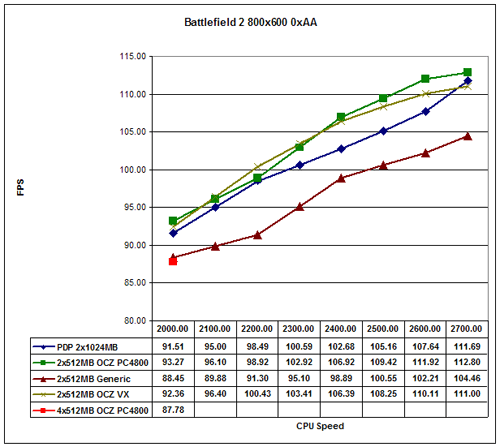
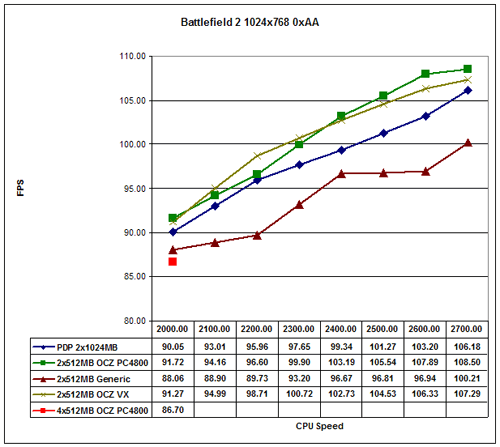
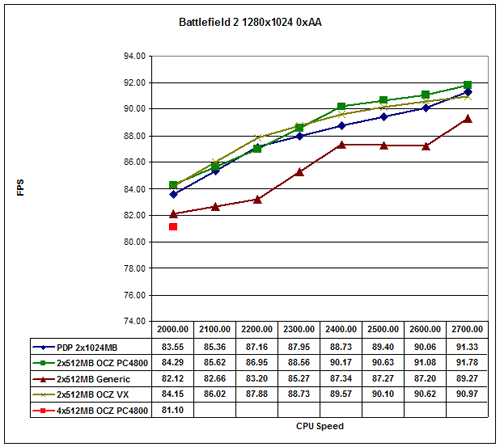
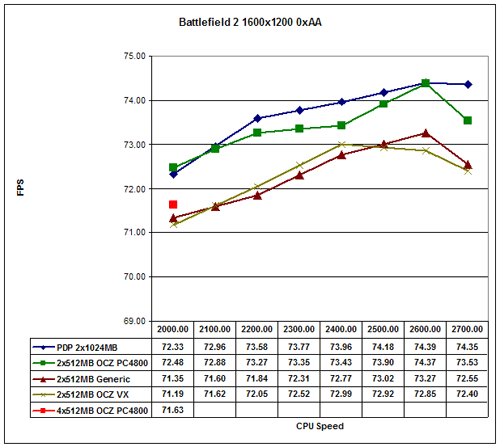
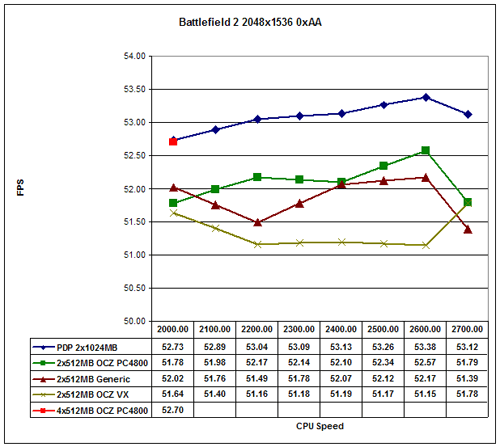
At lower resolutions, performance scales nearly linearly with processor speed. However, at more common resolutions for high-end computers, the graphics card quickly becomes a limiting factor. At 800x600, there's a 38% spread. That drops to 31% at 1024x768, 18% at 1280x1024, and 10% or less at the highest resolutions. This is without antialiasing enabled, and high resolutions with 4xAA are almost completely GPU limited.
The choice of RAM has a pretty large impact when we are CPU limited, but as resolution scales, it becomes less important. One thing that you can't see very well from the graphs is the impact that 2 GB of RAM has on hard drive access. At the higher resolutions, the increased memory size comes out on top, and it also provides more consistent frame rates. There is little to no hard drive access when you have 2 GB of RAM and are playing Battlefield 2. Level load times are also about 50% faster with 2 GB of RAM, and BF2 also exits quickly if you have more RAM.










46 Comments
View All Comments
rekabwolrab - Friday, February 24, 2006 - link
I'm new to OC and both the articles were very nice. Good Job. I am looking forward to the next installment with HSF/Cooling.shoeish - Friday, February 24, 2006 - link
Any results to share about watercooling or stock HSF with this chip yet?mcpdigital - Wednesday, December 28, 2005 - link
This article comes in the right moment since lots of people are thinking about upgrading their PCs or just did it.In my case I have a pretty simmilar configuration with LanParty Ultra-D, 3800 X2 and OCZ EL 3200 (2x1GB).
I found the breakeven of my setup at 280x9(2520), Mem at 210 MHz CAS 2,3,3,5 1T and HT x 3. Memory is running at its best, with 1T, Fastest in BIOS and CAS2 achieving around 61000 MB/s transfer rate running Sandra 2005 Pro, a value that is a bit under the maximum bandwidth with HT @1680 MHz of 6720MB/s
Anything over this speed makes the system unstable and requires a lot of slowdowns in other settings, voltage and temps raising fast, its a bad tradeoff IMO.
So Anandtech simple of the 3800 X2 seems a little better than mine, not that I'm not happy, I'm for sure.
Marcelo
Some1ne - Sunday, December 25, 2005 - link
Re: If you have any specific requests or suggestions before then, let me know.I noticed that as you increased the clock speed, you also increased your chipset voltage in a fairly linear way. I question whether or not this is really necessary or beneficial. I have a MSI Neo4 Platinum mainboard, and I've never had to touch the chipset voltage when overclocking. In fact, some of the behavior I observed when playing with it seemed to imply that the chipset got slightly less stable with higher voltages (though I didn't do enough testing to know conclusively if the relationship holds or not). Using the stock chipset voltage, I was able to hit:
2464 MHz (352x7) on a Winchester 3000+ w/ 6.6% over-VID on the CPU
2420 MHz (242x10) on a Manchester 3800+ w/ 10% over-VID on the CPU
2400 MHz (400x6) on a Winchester 3000+ w/ 6.6% over-VID on the CPU, just to see if the board would run stably at a 400 MHz "fsb" setting...it did
So as far as I can tell, boosting the chipset voltage is not necessary in order to attain a good overclock. It might be interesting if you could do tests to see what, if any, impact it has on stability at higher clock speeds, or maybe at least re-run your 2.7 GHz tests with stock chipset voltage just to make sure that your instability wasn't coming from an overheating chipset.
JarredWalton - Monday, December 26, 2005 - link
The results reported are only after testing all of the lower voltages. I encountered instability without the increased voltage to the chipset and processor. That said, other motherboards may not behave the same. I intend to switch to a different motherboard for the cooling tests -- a DFI LanParty SLI-DR. I will be sure to comment on whether the voltage requirements change or not.AtaStrumf - Friday, December 23, 2005 - link
Just want to commend you for a really thorough article. I miss that from other AT editors as of late.I also agree that all that ultra high end memory with tight timings is an absolute overkill for all but the most rabid overclockers. This is especially true since Athlon got an on die memory controller and became Athlon64. Just get some good quality RAM that will get you to 220-233 MHz so you have some headroom with BIOS FSB/dividers settings, because generic usually craps out at 201-203 MHz (sad but true).
Visual - Thursday, December 22, 2005 - link
Fantastic article, folks!It really showed alot. Sure, as someone commented, using a better mobo might have been interesting... but after all its the CPU that is important here, and you made the differences in performace with varying oc well presented.
I have to say, this article showed a surprisingly high difference between memory types too. You did comment in the end that there wasn't much difference, but there are some cases where there is :) 3dMark05 is the extreme case i guess, and not "real world" enough to be worth the added price, but 15fps or more in a lot of games from going from generic to the PC4800 mem isn't bad too. Seriously, this article showed the importance of memory way clearer than any of your RAM roundups in the past.
What is still dissapointing is that the test didn't reach the near-3ghz ocs a lot of people are bragging with on some forums :p But this is a good thing in a way, as now there won't be any misled readers buying the chip and expecting unrealistic achievments. I'm still curious about what the chips can do at max though, so I'm looking forward to your stock/Chill tests :) Maybe comparison with both infinity and lanparty boards? Maybe trying out several chips so you can give us a somewhat more realistic max average oc? (Hehe, no, scratch that last one. I don't want AT going broke from buying out all the X2s, plus no matter how many chips you test, the readers' own luck will deviate from yours)
Visual - Thursday, December 22, 2005 - link
Oh hey, I want to add a bit but there is no edit feature. So here goes...The RAM difference is much higher than with the singlecore veince. This does match with the assumption that two cores would need (and benefit) more bandwidth. So it also brings hope that the move to AM2 and DDR2 will have an even further boost, atleast for the dualcores. I'm already drooling over an imaginary AM2 X2 oced with DDR2 800mhz ram or faster :p
JarredWalton - Thursday, December 22, 2005 - link
I would say the performance difference shown here (relative to Venice) is from two things. First, two cores can use more bandwidth, though most of these tests won't show that since they're single-threaded. Second, the faster graphics card allows the CPU to really stretch its legs.Once you're at realistic settings for this system (minimum 1280x1024 resolution), the scores get a lot closer. Also, 3DMark has a pretty large deviation between runs - probably 3% or so. I didn't run 3DMark multiple times looking for the best score, so the results may not present a completely accurate representation of performance. Still, the CPU tests do show generic RAM at a pretty major disadvantage as clock speed increases. If 3DMark05's CPU test is an accurate estimate of multithreaded game performance, we're looking at a 25% difference! But I wouldn't put too much stock in 3DMark05. :p
Visual - Friday, December 23, 2005 - link
From what I read on the futuremark forums once, even though 3dmark05 is multithreaded, vertex processing in cpu tests is singlethreaded (some dx9 functionality from MS, not developed by futuremark) so isnt taking full advantage of dualcores still.